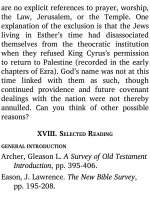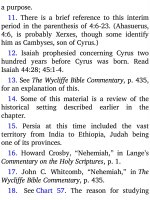Jensens survey of the old testament adam 66
Bạn đang xem bản rút gọn của tài liệu. Xem và tải ngay bản đầy đủ của tài liệu tại đây (162.32 KB, 4 trang )
fteenth century B.C. (based on the 1445
date for the Exodus from Egypt).
D. RELATION TO THE NEW TESTAMENT
B.C.
The predictive symbols, types, and
shadows found throughout this third book of
the Bible nd their ful llments in the New
Testament. For example, the blood sacri ces
point to Christ as the Lamb of God. The
priests typify Jesus as the Great High Priest.
The worshipers in Leviticus foreshadow the
New Testament Christians.
A list of the New Testament references to
Leviticus is given later, under Further Study.
The best biblical commentary on Leviticus is
the book of Hebrews.
III. SURVEY
1. In your survey of Leviticus, follow the
same study procedures described earlier. (To
conserve space, these general procedures
will not be repeated for the remainder of
this study guide. However, individual steps
of that general process will be suggested
along the way.)
2. Observe among other things that
Leviticus opens with an exhortation to
voluntary consecration (freewill o ering)
and closes on a similar note (freewill vows).
3. Note especially groupings of chapters
with similar subject matter. For example,
the rst seven chapters describe the laws of
the ve o erings.3 After you have looked
for other groupings, compare your ndings
with those shown on the survey Chart 22.
4. Study carefully the survey Chart 22.
What one word represents the whole book?
What outline divides the book into two
parts? 4 Read 18:1-5 and notice how these
words introduce a new theme, that of doing
and living, or, the walk with God.
5. Study the outline shown just below the
base line on Chart 22. How is holiness
prominent in the outline? Scan the chapters
in your Bible to see the bases for the
groupings. This is an e ective way of
surveying the book.
6. Leviticus has a twofold theme, which
may be stated thus: the way to God and the
walk He demands. Keep surveying the book
until it is clear to you that this theme
represents its message.
IV. PROMINENT SUBJECTS
A. GOD’S HOLINESS AND MAN’S SINFULNESS
The inescapable fact of a dichotomy of
God’s holiness and man’s sinfulness is the
universal basic problem confronting all
people. The entire message of Leviticus is
directed to it. The book’s good news is that
there are atonement and cleansing for man’s
sin to redeem him to God, and daily
fellowship with God is possible for those
who obey His directions. Keep this in mind
as you read the Bible text.
B. LAWS
Leviticus is the most thoroughly legalistic
book in the Bible.5 The many laws which
appear in its pages are of di erent kinds:
general or speci c; ceremonial, social, or
moral; temporal or timeless; punitive or
reparative. Burton Goddard writes:
By means of the ceremonial law, God
spoke in picture language of the
salvation He was to e ect through the









